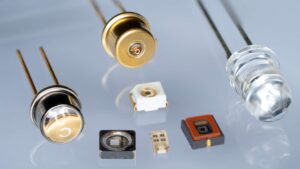Product news
New high power visible-NIR broadband LED
The nearby black body emission spectrum of halogen or incandescent lamps lead to a preferred usage in various measurement applications like spectroscopy and hyperspectral imaging. But this technology has lost its importance for visible light sources in general lighting due to their lower luminous efficiency and the availability attenuates continuously.The massive progress in LED technology enabled OSA opto light the development of broadband emitters based on short wavelength LED in combination with phosphors. The last generation of this development, the OCL-480 GIR, represents a new milestone for broadband high-power emitters and shows excellent performance between 460 and 1000nm.With a radiant power of 450 mW at 1000mA in pulse operation this LED is ideal for applications in life science, spectroscopy, spectral resolved image analysis and chemical analyses. Especially the unique broadband peak between 900 and 1000 nm and the remaining blue peak from the excitation equilibrates the attenuated sensitivity of silicon-based detectors in this wavelength ranges.





